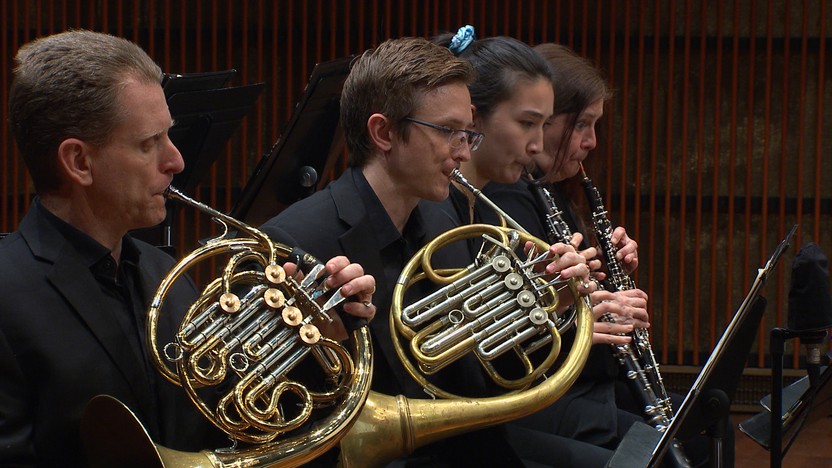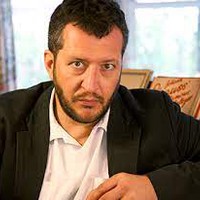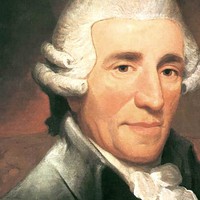Haydn’s Symphony No. 43



Thomas Adès only dedicated himself to composing at age nineteen, a year after earning second place in the BBC’s Young Musician of the Year competition as a pianist. In his twenties, he rose to the top echelon of contemporary music, causing a stir with the risqué opera Powder her Face (1995) and becoming the youngest ever winner of the prestigious Grawemeyer Prize for his orchestral work Asyla (1997).
Another early Adès work that has held its lasting place in the repertoire is his first string quartet from 1994, Arcadiana. As the Merriam-Webster dictionary tells us, “English speakers often use arcadia to designate a place of rustic innocence and simple, quiet pleasure.” Adès’ Arcadiana is a study of such places — some tangible, and others as rendered by composers and other artists. In a preface to the score, Adès simply referred to “more local fields” as his inspiration for the tranquil sixth movement, which takes its name from a very old name for England, Albion.
Aaron Grad ©2021

When Prince Nikolaus Esterházy completed a lavish country palace in 1766, the workload for his tireless Kapellmeister, Franz Joseph Haydn, increased dramatically. The “summer” seasons at the estate stretched to be nearly year-round, and all the while Haydn had to produce operas, provide music for church services, mount concerts, and attend to any other musical needs for his insatiable patron. “In Eszterháza,” Haydn lamented/boasted, “I was forced to become original.”
The symphony as we know it was in its infancy when Haydn took up the genre in the early 1760s. A decade and some forty symphonies later, he continued to push the boundaries in all sorts of directions: more instruments, more emotions, even more movements. The Symphony No. 43 was less outwardly radical than the two that followed — both examples of symphonies in minor keys that reflected the trend of Sturm und Drang (“Storm and Stress”) showing up in various art forms of the era — but even this seemingly placid Symphony in E-flat Major contains a multitude of original ideas. The first movement is an unusually expansive example of a sonata-form movement constructed essentially out of one main theme (recognizable by its repeated keynote), a specialty of Haydn’s. The same repeating note takes on a new context in the main theme of the Adagio, and a minor-key episode that obsesses over that repetition in a short-short-short-long rhythm makes plain how much Ludwig van Beethoven owed to Haydn, his onetime teacher.
Lo and behold, the Menuetto (another Haydn signature, inserted within the original three-movement symphony template) is built around a theme that repeats the same note, E-flat. After three movements celebrating the joys of musical sameness, the finale brings an explosion of kinetic activity, building restless themes out of long chains of arpeggios and scales. The source of the symphony’s nickname is unknown; might it be that this fleet-footed music reminded some earlier listener of Mercury, the winged messenger among the Roman gods?
Aaron Grad ©2021
THESE PERFORMANCES ARE CANCELED
Given the rapid spread of the highly transmissible Omicron variant in our community, we have made the difficult decision to cancel concerts in our Neighborhood Series venues through March 13.
Those with tickets to canceled concerts can exchange tickets for another concert, turn the value of your tickets back as a tax-deductible donation to the SPCO or bank them in your account for use at a future concert. Refunds may also be requested by contacting the Ticket Office at tickets@spcomail.org or by calling 651.291.1144 during Ticket Office hours (12–5pm Monday–Friday, 11am–3pm Saturday). Any tickets that are not donated, exchanged or refunded will be banked in your SPCO account for later use.
We began our season this fall by performing only at the Ordway Concert Hall, where we could concentrate our efforts on providing the safest possible concert environment with enhanced ventilation, adequate room for distancing in the hall, on stage and backstage, and a professional usher staff to implement safety measures. We were hopeful that the pandemic situation would have improved enough by January that we could return to our Neighborhood Series venues this month. Unfortunately, with case numbers surging in our community, we need to remain focused on providing concerts in just one location at this time. Therefore, all SPCO concerts outside of the Ordway are canceled through March 13. We will continue to assess the environment and prioritize the health and safety of our audience, staff and musicians, and we hope to resume our Neighborhood Series performances after March 13.
All SPCO performances at the Ordway will continue, as scheduled, barring further positive COVID-19 tests or confirmed exposures among our musicians, stage crew and concert staff in the coming weeks.
The hushed tones of Thomas Adès’ string quartet O Albion creates a watercolor backdrop for the symphonic architectures of Karl Amadeus Hartmann and Franz Joseph Haydn. Atop this cloudlike aura brims the Chamber Concerto of Hartmann, widely recognized as one of the 20th century’s great symphonists, showcasing the dynamic versatility and grandeur of smaller ensembles. Ending the evening is Haydn’s Symphony No. 43, a work that highlights the delicate balance between the winds and strings.
All audience members are required to present proof of full COVID-19 vaccination or a negative COVID-19 test within 72 hours prior to attending this event. Masks are required regardless of vaccination status, and high quality masks, such as N95 respirators, are recommended over cloth or surgical masks. More Information
Concerts are currently limited to 50% capacity to allow for distancing. Tickets are available by price scale, and specific seats will be assigned and delivered a couple of weeks prior to each concert — including Print At Home tickets. Please email us at tickets@spcomail.org if you have any seating preferences or accessibility needs. Seating and price scale charts can be found at thespco.org/venues.
Get driving directions and find nearby parking.
Find dining options close to the venue.
View seating charts to find out where you'll be seating.
Get driving directions and find nearby parking.
Find dining options close to the venue.
View seating charts to find out where you'll be seating.
